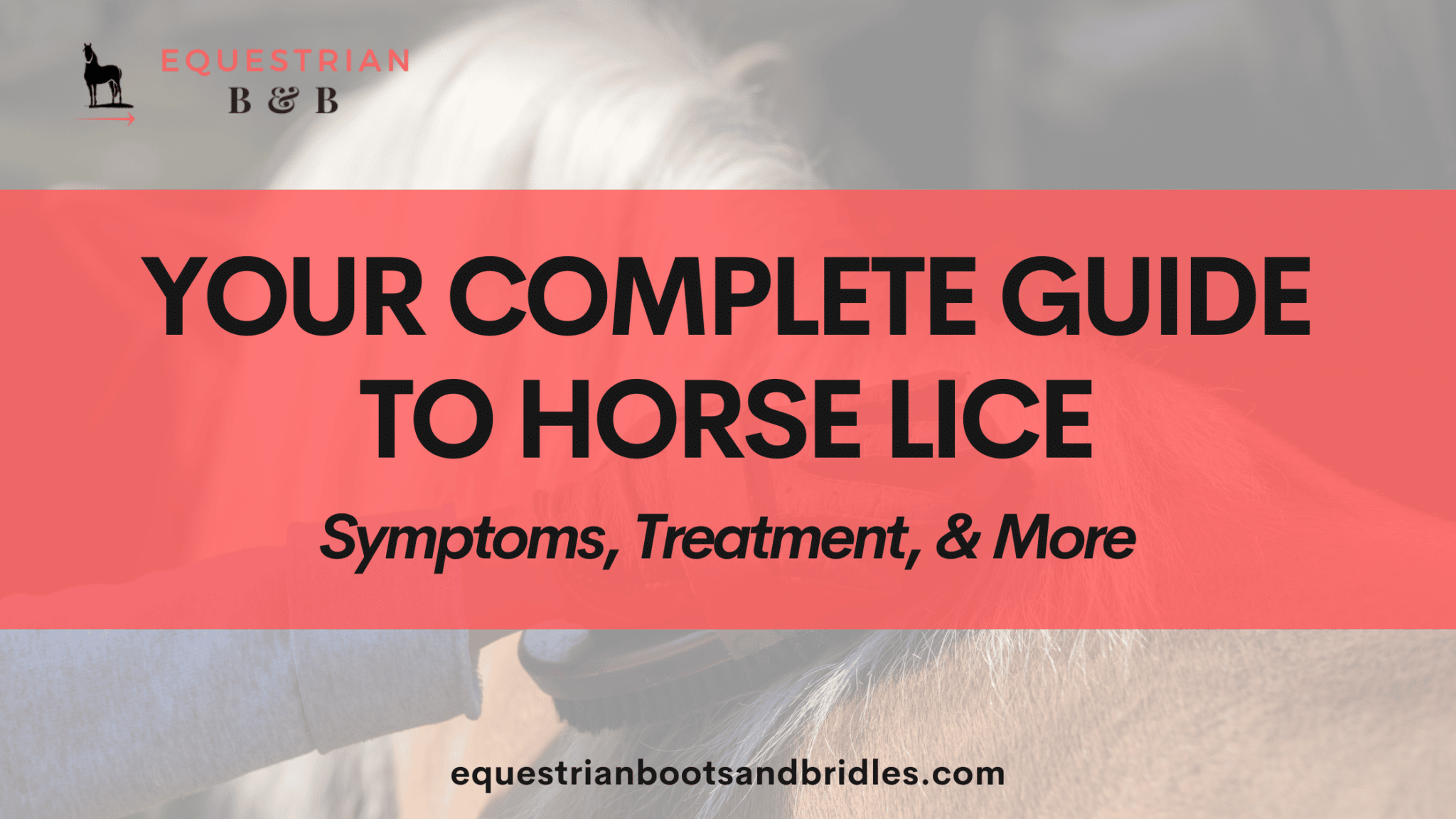Lice. No one likes them, no one wants them, and when you find them on your horse, they’re lousy! Lice make your horse itch to the point of rubbing off its hair and ruining its appearance, as well as making your horse uncomfortable. You want to get rid of lice the moment you see them on your horse so as to prevent their transmission to other horses in the herd and barn.
Horses get lice from their pasture-mates and sometimes from being groomed with brushes that have lice on them. Fortunately for horse owners, horse lice can’t make their homes on people. The species of louse that infests horses can’t thrive on humans, and there is no possibility of transmission. Breathe easy as you handle a horse with lice and provide treatment for horse lice with confidence as you’re not at risk.
The following guide to horse lice will help you understand what a horse louse is, how a horse gets them, and what steps you should take after discovering lice on your horse.
This article contains affiliate links, which means we may earn a commission if you choose to make a purchase (at no extra cost to you). All of our recommendations are honest!
Types of Lice on Horses
There are two types of lice that are found on horses. The most common type of lice is known as Haematopinus asini, a bloodsucking louse. They look like this:
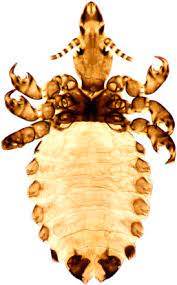

The other kind is called Bovicola equi, which is a biting or chewing louse. These ones look like this:
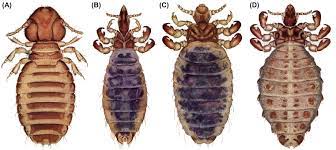
The biting louse feeds on skin secretions and skin cells, and the bloodsucking louse pierces the hair root in the same manner as a mosquito. Both lice prefer to infest different parts of a horse’s body, with the biting louse preferring the finer hair on the neck, flank, and base of the tail. The bloodsucking louse infests the roots of the mane, forelock, the base of the tail, and the feathering around the hoof.
A lice infestation is known as pediculosis. You may hear this term or see it written down as part of a veterinary diagnosis.
When it comes to spotting lice, it’s easier to see chewing lice because they move faster than the sucking lice. You may see them moving around as they look for their next meal, but keep in mind that lice have a tendency to stay in place regardless of species. Lice are incapable of flight and can’t jump, which means they spend their entire lifecycle on the same horse and won’t move far from their feeding grounds. Their diminutive size also makes it difficult to see them—the chewing lice are less than a tenth of an inch in length, and the sucking lice are about an eighth of an inch in length.
As you can see from the photos above, both types of lice have a distinctive appearance, although they are similar in their build. The chewing louse has a narrow, pointed head with six large legs in between its oval-shaped thorax, while the sucking louse has a round head, small legs behind its head, and an elongated lozenge-shaped thorax. Horse lice differ in color from human lice and are yellowish-brown instead of white. Eggs are white in color.
An infestation is most likely to occur in the late winter and early spring, but lice can be observed on a horse outside of these seasons.
Lice can live their entire lifecycle on a horse after an initial infestation, and both types of lice have a similar lifecycle. The female lays her eggs, known as nits, on the hair shaft of the horse. A natural adhesive on the egg case enables it to attach to the hair shaft. After five to 20 days, nymphs emerge from the eggs and begin to feed immediately after hatching. It takes anywhere from two to four weeks for a nymph to reach full maturity and begin the lifecycle once again. The entire lifespan of the louse is anywhere from 20 to 40 days total.
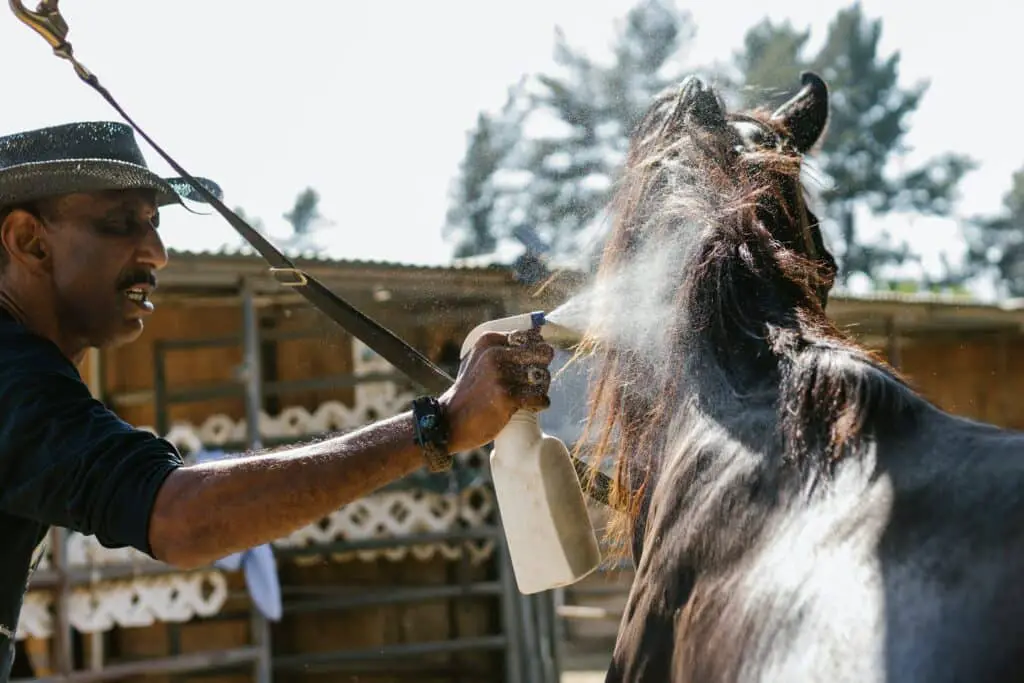
Symptoms That Indicate Your Horse Has Lice
Horse lice symptoms mimic other skin issues and you may overlook the appearance of lice if the infestation is minor. As you search for the cause of your horse’s discomfort, look closely for the telltale signs of nits on hair follicles to determine if your horse has a lice infestation. Look under the mane and forelock, and pull the hair aside on the tail dock. Also check the hair coat in the areas where your horse is showing signs of irritation for nits and insects.
Horse lice symptoms include:
- Scratching
- Biting
- Rubbing
- Itching
- Hair loss
- Matted hair
- Open sores and wounds
- Poor physical condition
A horse that’s already in poor condition due to age or a chronic condition is likely to show signs of depletion due to blood loss. Their immune systems are also less able to respond to the lice, causing further physical deterioration.
How to Find Lice on Your Horse
At first glance, a lice infestation may look like dandruff due to the fact the lice don’t clump together and both adults and eggs tend to be spread out. However, adults and eggs tend to stay close because they’re slow movers and don’t like to go far to take care of their egg laying and feeding needs.
A flashlight and a magnifying glass can help you detect the presence of lice, and the flashlight feature on your cell phone is your best tool for finding lice. Start by lifting the hair in an area that you suspect has lice, and illuminate the hair shafts with the flashlight. Use the magnifying glass to help you zoom in on what you find. If you see nits at the base of the hair shafts, you can be sure that your horse has lice.
In the event you don’t see nits or adult lice on your horse, you can ask your vet for assistance. The vet may ask you to take a scraping from the area and bring it to the office for viewing under a microscope to confirm or rule out the presence of lice.
You can safely touch another horse after handling a horse that has lice. Transmission of lice from one horse to another via your hands is highly unusual (although there’s always a possibility!). If you’re concerned about transmitting lice, use gloves as you treat an infested horse and take them off before handling another horse. Washing your hands in between handling different horses is good practice as well.
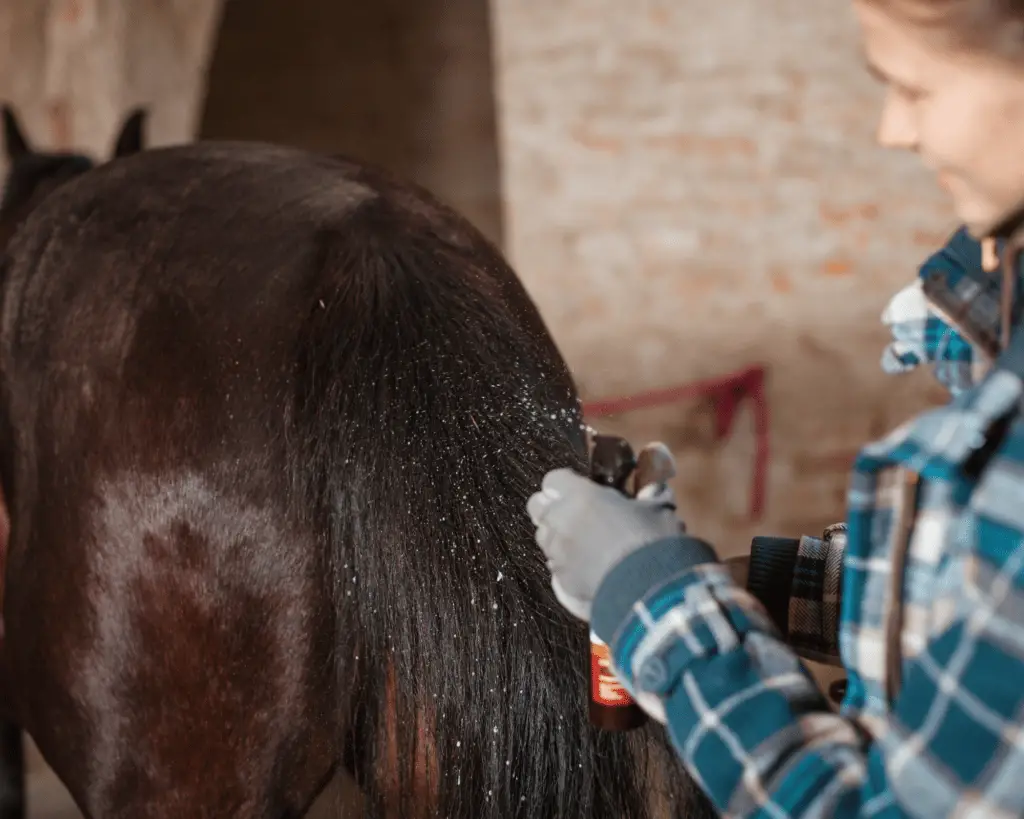
Preventing the Spread of Horse Lice
Discovering your horse has lice has immediate implications for your horse and its companions and/or the rest of the boarding barn. The first thing to understand about a horse getting lice is the fact it has nothing to do with the quality of your husbandry. Horses are prone to picking up insects, and lice are prevalent in most areas of the United States. They’re also easily transmissible so when one horse has lice, the chances are good that other horses in the group also have lice (even if you keep your horse really clean). That’s why it’s important to take fast action after you’ve discovered lice on your horse.
1. Clean all grooming supplies and sheets
Isolating a horse with lice isn’t necessary, but you need to start treatment as soon as possible. Soak your grooming supplies in a cleaning solution that kills lice and do the same for community brushes. Clean sheets by soaking them in a bucket of warm water and detergent prior to putting them into a washing machine on the hot water or sanitizing cycle. If the sheets can be dried in a dryer, use the maximum heat setting that’s set by the manufacturer. Lice die quickly after exposure to high temperatures, and the use of high heat for washing and drying serves to kill any lingerers.
2. Clean out stalls and areas of common contact
Cleaning stalls and wood surfaces where your horse has been in contact with isn’t necessary. Lice can’t live very long when they’re not on a horse, and the potential of a horse picking up lice from these surfaces is almost impossible. However, if you do feel that you’d like to sanitize surfaces, you should strip the bedding out of the stalls, clean off cobwebs and dust, then spray down the surfaces with a solution of bleach and water.
3. Treat pasture-mates and stall neighbors
It’s a good idea to treat all horses that have come into contact with an infested horse even though they may not be showing any signs of lice. All it takes is a single pregnant louse to lay eggs on a horse for an infestation to occur. Precaution is the best course of action when it comes to preventing the spread of horse lice. (Keep reading for how to actually go about treating horses.)
4. Groom and bathe regularly
Regular grooming helps to dislodge the nits and adults and also helps you track their existence and eventual disappearance. Make sure to use a set of brushes that you’re prepared to deep clean or get rid of with after you’ve eliminated the lice, and don’t use them on other horses.
Bathing also helps get rid of lice, and when combined with a horse lice shampoo, it can be very effective in giving your horse relief from their biting and sucking in less time.
What Could Happen if You Don’t Treat Horse Lice
Most healthy adult horses are capable of withstanding a lice infestation. That is, lice don’t have an easy time of making a healthy horse their home. That’s not to say a horse in good condition won’t get lice, it just makes it less likely. Horses in poor physical condition are ones that are at the highest risk of getting infested with lice and suffer as a result.
Both healthy and compromised horses can suffer from lice if not treated. It just takes longer for a healthy horse to become depleted than it does for a compromised horse. Lice are bloodsuckers and when left untreated, can make it harder for a healthy horse to thrive. A horse that’s older or has a chronic condition won’t be able to tolerate the loss of blood from an unchecked lice infestation.
The damage lice can do to a horse isn’t immediately apparent. It can take time for a healthy horse to show signs of depletion in the form of a dull coat, open sores, and loss of hair to the mane, forelock, and tail. Unexplained weight loss can also occur. Depletion will show up sooner in a horse that’s older, has a compromised immune system, or other chronic condition.
Types of Treatment for Horse Lice
You have multiple options when it comes to treatment for horse lice that range from home remedies for horse lice to buying over-the-counter anthelmintics in oral and topical forms. Products that kill lice are known as pediculicides, but anything that kills insects are effective against lice. All treatments for horse lice are known to be effective against lice when applied according to directions or conventional wisdom. As long as you follow directions and are diligent in applying the treatment to your horse, you’ll be able to easily eliminate an infestation of horse lice. Here’s a look at some of the treatments for horse lice.
Horse De-Wormers
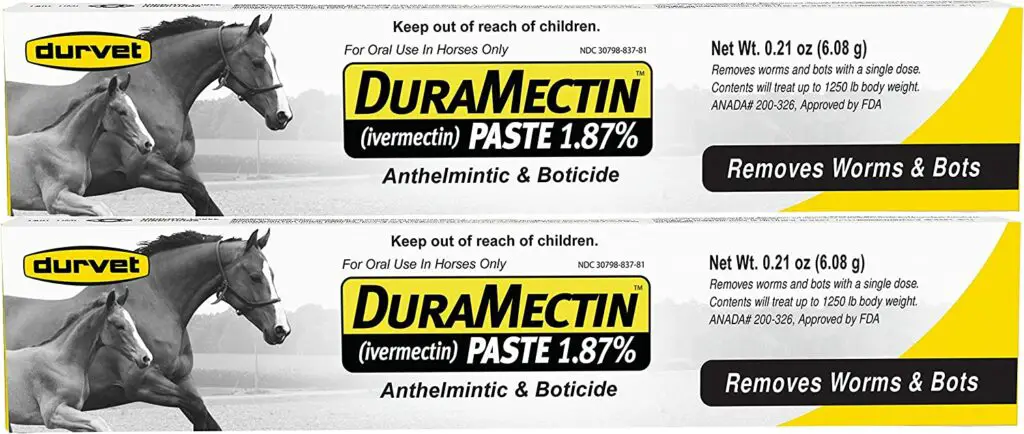
De-wormers contain ingredients that are lethal to insects and worms alike, but they’re mainly effective against sucking lice. The ingredients in the de-wormer circulate throughout a horse’s bloodstream and are readily ingested by the sucking lice. Biting lice may not get enough of the active ingredient into their system for it to be effective. Check the label of the de-wormer to find out if it’s recommended for use against biting lice.
Buy DuraMectin Horse De-Wormer Paste on Amazon
Horse Lice Shampoo
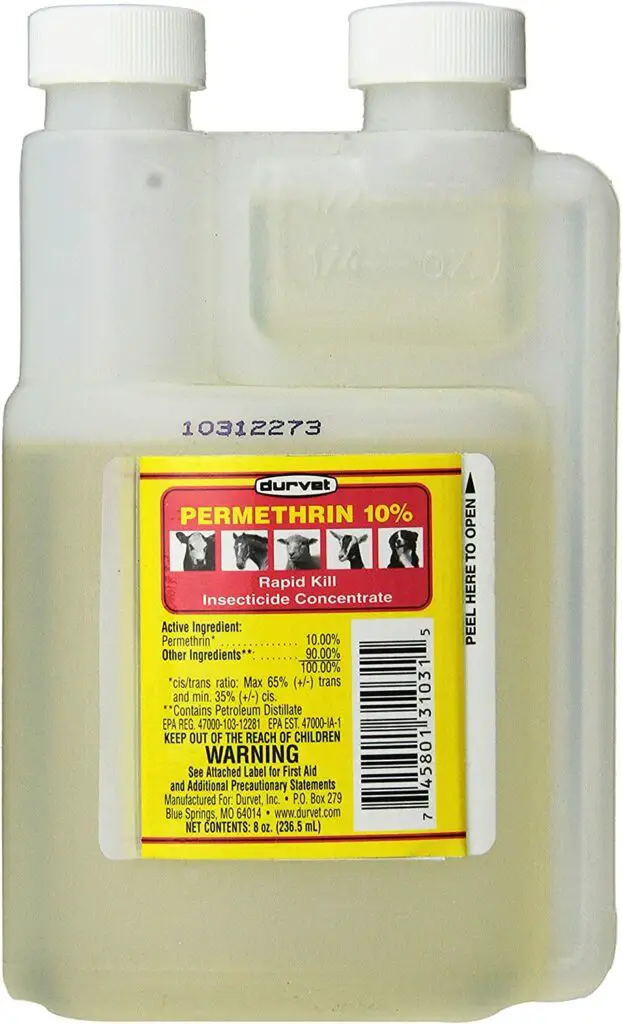
Shampoo for horse lice comes in various forms and active ingredients. You can use a pour-on or spray-on liquid like this one that you wash off after a period of time or use a shampoo that contains pyrethrins or coumaphos. Pyrethrins are used in fly spray and are a neurotoxin that’s effective at killing lice and horse lice eggs.
Buy Durvet Lice Shampoo on Amazon
Horse Lice Spray
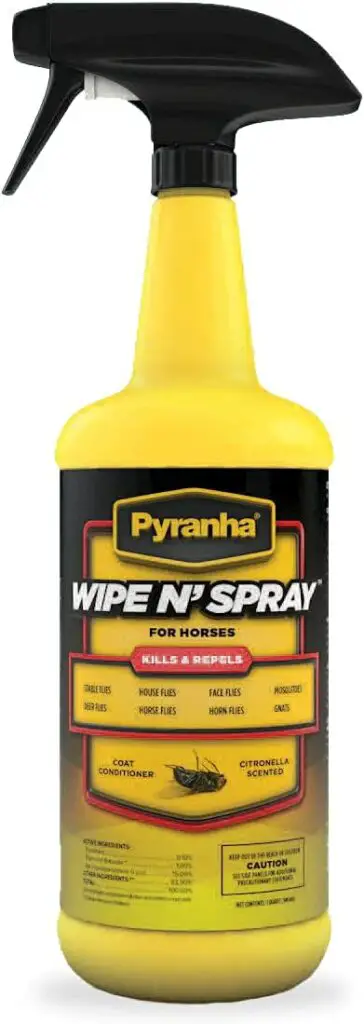
The active ingredient in most horse fly sprays is actually effective against lice and flies alike. The only drawback to the spray is the need to reapply it on a regular basis. You can spray your horse down prior to releasing them into the pasture for protection and active killing of lice. This can be a good preventative measure for keeping the lice from spreading to other horses in the barn, too.
Buy Pyranha Horse Lice Spray on Amazon
Horse Lice Powder
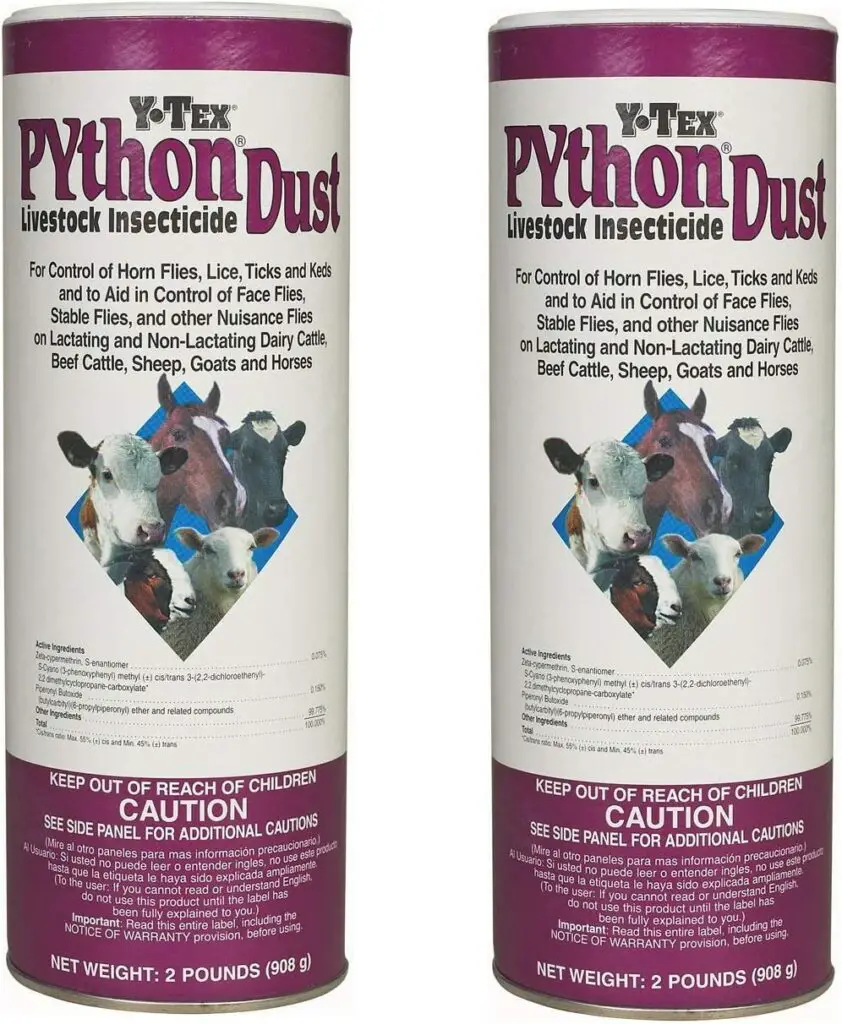
Horse lice powder is an excellent option for horses who have thick coats or manes and tails. You can work the powder into these areas and let it stay there for the lice to come into contact with it.
With all of these products, make sure to read the directions on the label and follow them diligently to ensure eradication of the lice. You may need to reapply treatment about three weeks after the initial treatment as horse lice eggs may survive the original application of the treatment.
Home Remedies for Horse Lice
A number of organic and home remedies for horse lice have been found to be effective in the killing of lice. Home remedies for horse lice may not be as convenient to use as a commercially produced product, but for some horse owners, the inconvenience is negligible as a natural product is preferred over harsh synthetic chemicals.
Plant essential oils
Six essential oils from plants have been found to be effective against horse lice. They are:
- Peppermint
- Eucalyptus
- Clove bud
- Camphor
- Tea-tree
- Lavender
Using a 5 to 10% concentration of any of these oils resulted in 100% mortality when applied to chewing lice.
Vinegar
Regular or apple cider vinegar works well for killing lice. It can be used straight from the bottle and applied directly to the affected area.
Neem oil
This remedy is best used on the mane and forelock. Work the neem oil into the affected area, then let it sit for an hour. Neem leaves can also be used, but they need to be boiled to release the oil. After the water has cooled, soak the mane roots with the neem water and let sit. For neem oil, shampoo and comb the treated area, and use plain water to rinse out the neem water.
Tea tree and olive oil
Mix equal parts tea tree and olive oil together, then rub into the affected area. Wait at least a half-hour for the oils to take effect, then shampoo the oils out. Use vinegar to loosen nits, and comb out to get rid of any remaining lice and eggs.
Dishwashing liquid
Most dish soaps have degreasing properties which are effective on the “glue” that holds nits to hair follicles. Shampoo your horse with the dish soap and let the soap sit for about half an hour. Wash out the soap and use a comb to pull the nits off.
When do You Get the Vet Involved?
It’s always a good idea to ask your vet to confirm or rule out the presence of lice on your horse. Finding lice on your horse isn’t an immediately life-threatening problem, but it’s still something that needs to be seen to as soon as possible. Veterinarians have their preferred way of confirming the presence of lice which can involve a farm call, a picture of the affected area, or bringing in some hair follicles for viewing under a microscope.
Call your vet as soon as you suspect the presence of horse lice for advice and treatment of the problem. It’s especially important to make a call with an older horse or one that’s suffering from compromised health. There may be an underlying condition that needs reinforced treatment to help the horse get through the infestation and minimize further health deterioration.

